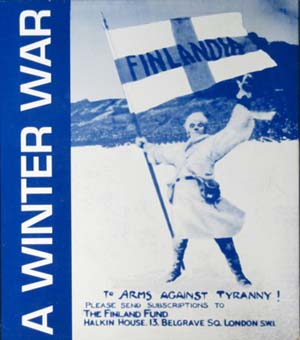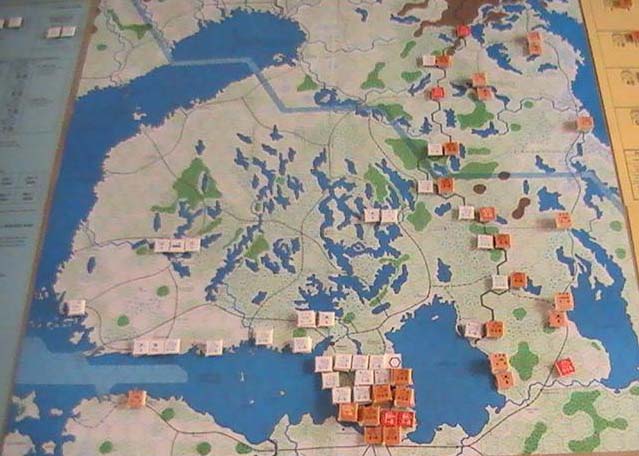 |
 |
| Introduction October, 1939, the Finnish delegation listened to Comrade Stalin's ultimatum that Finland give in to Soviet demands for their territory. Attempts on Finland's part to reach a compromise were refused. On November 30, without a declaration of war, the Soviet Union invaded Finland and thus began the Winter War.In this historical recreation of that war, Finland's small but effective army faces the Soviet giant. Finland had only 120,000 troops, less than 50 modern aircraft, and virtually no modern weapons. But the Finnish soldiers were well trained, tenacious in the defence of their homeland, and expert in 'irregular' warfare. The Soviets began the war with over 300,00 troops, hundreds of modern aircraft and tanks. By December's end the Finns had inflicted 27,000 casulaties on the Red Army while suffering only a tenth of that number. This disaster caused the Soviets to reorganize their armed forces. |
| On
February 1, 1940 the Red Army renewed its offensive. With massive force they repeatedly
struck the main Finnish defensive position, the Mannerheim Line, and within ten
days they broke through. On March 8, 1940 the Finns sued for peace and Stalin won his demands. A Winter War is a detailed simulation of the Soviet invasion of Finland during the winter of 1939-40. A Winter War is a two player game, with one player representing the Soviet high command (STAVKA) and the other the Finnish high command (Paamaja). The Soviet player must break Finland upon the field of battle, capturing territory, inflicting losses, and isolating Finland from outside help, so that the Finnish political leadership would have no choice but to sue for peace on Soviet terms. The Finnish player must weather the Soviet storm-giving up ground reluctantly, inflicting as many losses as possible, and keeping his army intact-in such a manner that it would be advantageous for the Soviet political leadership to agree to a negotiated peace. Both sides maneuver their forces and conduct combat in an attempt to achieve their goals. |
| Basic
Game Concepts A. Units. The term units, when used by itself, refers to ground units only and does not include air or naval units. The term forces refers to ground, air, and naval units collectively. Units are rated based on their size, type, and capabilities. Typically, a unit has a unit size, a unit type, a combat strength (or separate attack and defense strengths), a movement rating, and a unit identification. The Unit Identification Chart displays the layout of these symbols and ratings, as well as all specialized symbols and ratings used in the game. Some overall definitions apply to units. 1. Size. Units are divided into two general cate gories, based on their size: · Divisional Unit. Any unit with the division or corps symbol, except for headquarters. Note: The Soviet 10th Tank Corps, which was organized and operated the same as a division, is the only corps-size combat unit in the game. This unit only appears when using Optional Rule 36C3. · Non-Divisional Unit. Any unit smaller than a divisional unit: brigades, regiments, cadres, and battalions. 2. Class. Units are divided into three general classes, based on their types: · Non-Motorized. All unit types listed as nonmotorized on the Unit Identification Chart. For example, a cavalry unit is non-motorized. · Artillery. All unit types listed as artillery on the Unit Identification Chart. For example, a siege artillery brigade is artillery. Note that for game purposes antiaircraft units are not artillery. · Combat/Motorized. All unit types listed as combat/motorized on the Unit Identification Chart. For example, a tank brigade is combat/motorized. Note: "Combat/motorized" is abbreviated "c/m" in the rules. "Non-c/m" units are those units that are not combat/motorized: all non-motorized units and all artillery units. 3. Regimental Equivalents. A regimental equiva lent (RE) measures the size of a unit or supply point. RE sizes are as follows: · 1/2 RE: Each battalion, point of position AA, or supply point. · 1 RE: Each brigade, regiment, or cadre. · 3 REs: Each divisional unit. Cavalry and c/m units count double their RE size for purposes of rail capacity (Rule 7A2). For exam ple, a tank brigade (1 RE) that moves by rail counts as 2 REs for rail capacity purposes. 4. Heavy Equipment. The Unit Identification Chart lists the unit types that have heavy equip ment. In addition, all units that have supporting arms (Rule 11) have heavy equipment. Units with heavy equipment may not be transported by air. B. Sides. 1. Finnish. The Finnish player controls the forces of Finland. The Finnish player also controls all Foreign Volunteer units (if any arrive), and all forces of the Western Intervention Force (if they intervene). 2. Soviet. The Soviet player controls the forces (Regular, Winter-Capable, NKVD, Air Force, and Foreign Contingent) of the Soviet Union. 3. Neutral. Estonia, Norway, and Sweden start the game neutral and are controlled by neither player. C.
Game Mechanics. |
| Sequence
of Play The game is played in a series of game turns, each representing one-half month. Each game turn consists of a Soviet player turn followed by a Finnish player turn. A. Sequence. Each player turn consists of the following phases: 1. Initial Phase. Both players determine the supply and isolation status of their units and hexes. The phasing player receives reinforcements and replacements, builds forts and airfields, and may attempt to repair inoperative air units. 2. Movement Phase. The phasing player moves his ground units. 3. Air Phase. Players move air units, resolve air combat, and execute air missions. 4. Combat Phase. Both players determine the isolation status of their units and hexes. The phasing player resolves attacks made by his units. 5. Exploitation Phase. The phasing player moves his eligible c/m units. B. Phasing. During the Soviet player turn, the Soviet player is the phasing player and the Finnish player is the nonphasing player. During the Finnish player turn, these roles are reversed. C. Restrictions. Unless noted otherwise, activities may not be conducted outside this sequence. The activities mentioned above are explained in the following rules. Zones of Control The zone of control (ZOC) of a unit represents the control the unit exerts over surrounding terrain. ZOCs affect many activities in the game, as covered in the appropriate rules. A unit exerts a ZOC through the six hexsides of the hex the unit occupies into the six surrounding, adjacent hexes. A unit prohibited from entering a specific terrain type or crossing a specific type of hexside does not exert a ZOC into that hex or through that hexside. For example, a unit prohibited from crossing a frozen sea hexside does not exert a ZOC through any frozen sea hexside. Every divisional unit has a ZOC. Brigades, regiments, and cadres have ZOCs only in hexes in weather zone A; they do not have ZOCs in hexes outside this zone. Battalions never have ZOCs. When a unit with a ZOC is unsupplied (see Rule 12), it has a reduced ZOC. Reduced ZOCs are the same as standard ZOCs, except for their effects on the movement of enemy units (Rule 6A). A unit with a ZOC may temporarily lose its ZOC, depending upon certain activities. For example, a unit which uses administrative movement (Rule 6B) loses its ZOC. When a unit undertakes such an activity, it loses its ZOC as specified in the rule. A unit which loses its ZOC does not have a ZOC for any game purpose until it regains its ZOC. Master Sequence of Play Summary The following is a list of activities that occur during the course of a game turn. Within each phase, activities are numered in the order they should be conducted. Activities within a numbering may be conducted in any order. Some activities are applicable only to a single side. The appropriate rules sections for the activities are given in parentheses. Start of Game Turn Initial
Phase Movement
Phase Air
Phase Combat
Phase Exploitation
Phase (Eligible Ski and C/M Units) End
of Game Turn When
Applicable: |
A
Winter War: Initial Setup  |
| Game
Mechanics Time Scale: 2 week turns Map Scale: 16 miles per hex Unit Scale: Divisions, regiments, battalions Players: Two - Intermediate Complexity Solitaire Suitability: High complexity Playing Time: 6+ hours | Scenarios |
Game
components: | Game
Strategy Classic hexagonal play game using established Europa rules. The game has one edition published in 1992. Storm Over Scandinavia was added to the Northern Theatre (known as NTO) in 1998 and thus to A Winter War to complete the whole area of the Northern Theatre of Operations. Storm Over Scandinavia also included Narvik, an earlier popular game in the same theatre. |
wargames.wilkey.org.uk |